

Graphic Design >> Refining Your Process: Implementing Design Process. Running the Innovation Pipeline. Process Innovation – Transfer some of the job to the customer. Online check-in for flights is a great innovation.

Instead of standing in line at the check-in desk I can select my seat and print my boarding card at the computer on my desk (or on my smart phone). For me, the passenger, online check-in offers time saving, control and convenience. For the airline it means less administration, fewer check-in desks and competitive advantage (I would rather fly with an airline that offers it). It is an example of a service innovation where part of the task has been transferred to the customer. Are You Cooperating Or Collaborating? The Answer Will Increasingly Influence Your Success. How to Bring Innovations to Market. How to Bring Innovations to Market. Innovation processes are almost always heavily front-loaded.
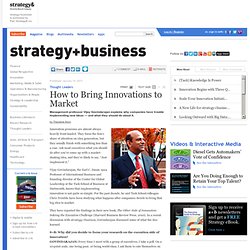
They focus the lion’s share of attention on idea generation, but they usually finish with something less than a roar. Ask most executives what you should do after you’ve come up with a market-shaking idea, and they’re likely to say, “Just implement it.” Vijay Govindarajan, the Earl C. Daum 1924 Professor of International Business and founding director of the Center for Global Leadership at the Tuck School of Business at Dartmouth, knows that implementing innovation is not quite so simple.
For the past decade, he and Tuck School colleague Chris Trimble have been studying what happens after companies decide to bring that big idea to market. They have reported the findings in their new book, The Other Side of Innovation: Solving the Execution Challenge (Harvard Business Review Press, 2010). Collaborative design, and the social TV case study. The rising gap between exploration and development Though innovation is supposed to process along the “rugby approach” defined by Professor Nonaka, innovation in large companies is more like a relay race.
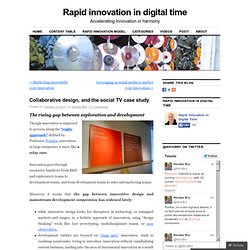
Innovation goes through successive handover from R&D and exploratory teams to development teams, and from development teams to sales and marketing teams. Moroever it seems that the gap between innovative design and mainstream development corporation has widened lately: while innovative design looks for disruption in technology or untapped markets and usages, in a holistic approach of innovation, using “design thinking” tools like fast prototyping, multidisciplinary teams, or user observation,development entities are focused on “stage gate” innovation, stuck in roadmap constraints, trying to introduce innovation without cannibalizing current business, landing into the area of incremental innovation as a result of multiple compromises.
Passing the culture of creative product Conclusion. Self-inflicted wounds caused by jumping hurdles and closing gates on innovation. Many organizations have made Stage-Gate or a mutation of it, their ‘go-to’ innovation process that all innovation must ‘somehow’ pass through. Squeezing all types of innovation through this, for whatever people claim is a linear process, is simply wrong. You can simply say: “we destroyed much to get sometimes so little out as the final outcome, when initially it was seen to be so promising.“ The difficulty is that we are still struggling to find a real alternative, although there have been some recent noteworthy attempts, firstly by Jose A Briones and his Spiro-Level 3D approach and then by Paul R Williams, of the American Institute for Innovation Excellence, to move the discussions beyond the Stage-Gate process from this linear into more spiral concepts and beyond.
Frugal Innovation: Lessons from Carlos Ghosn, CEO, Renault-Nissan - Navi Radjou, Jaideep Prabhu, Simone Ahuja. Carlos Ghosn, Chairman and CEO of the Renault-Nissan Alliance, famously coined the term “frugal engineering” in 2006.

He was impressed by Indian engineers’ ability to innovate cost-effectively and quickly under severe resource constraints. And under Ghosn’s leadership , Renault-Nissan has proactively embraced frugal engineering and become one of the world’s leading producers of both electric cars as well as low-cost vehicles — two of the fastest growing and most promising market segments in the global automotive sector. Recently, in New York, we participated in a panel discussion organized by the Asia Society called “Jugaad Innovation: Reigniting American Ingenuity” (you can watch a video here).
We were honored to have Ghosn as our key panelist. During the panel discussion, Ghosn explained that Western automakers must sacrifice the “bigger is better” R&D model and adapt to frugal engineering. 3) Tap partners in emerging markets who excel at innovating more with less. Steven Johnson: Where good ideas come from. Five Ways to Ruin Your Innovation Process - Rita McGrath. Most companies sabotage their own innovation processes without meaning to.
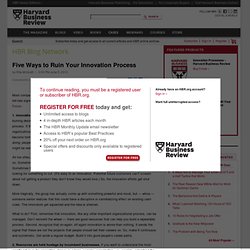
I’ve noticed five tell-tale signs of this syndrome, which I recently described during a talk to the Columbia Media Forum. 2 - The prevailing model of innovation - May 15 2012.pdf (application/pdf Object) 1 - What do you know - May 1 2012.pdf (application/pdf Object) - StumbleUpon. One of the biggest challenges when it comes to innovation is not just the generation of ideas.

Normally, people are able to be creative, especially when well stimulated by techniques such as brainstorming or design thinking. Self-inflicted wounds caused by jumping hurdles and closing gates on innovation. The hardest part of innovation. I was thinking about my talk from yesterday, and one bit that I just spontaneously threw in is probably worth expanding on.
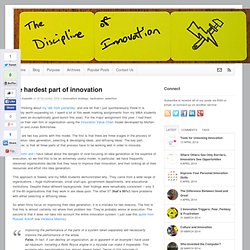
I spent a lot of this week marking assignments from my MBA students (who were an exceptionally good bunch this year). For the major assignment this year, I had them analyse their own firm or organisation using the Innovation Value Chain model developed by Morten Hansen and Julian Birkinshaw. There are two key points with this model. The first is that there are three stages in the process of innovation: idea generation, selecting & developing ideas, and diffusing ideas. Linking innovation context to the process. Time passes extremely quickly, particularly when you enjoy yourself, or so it seems for me.
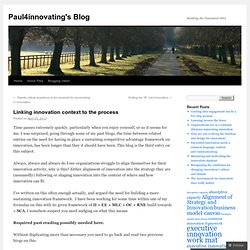
I was surprised, going through some of my past blogs, the time between related entries on the need for having in place a sustaining competitive advantage framework on innovation, has been longer than they it should have been. This blog is the third entry on this subject. - StumbleUpon. Knowledge - Morten Hansen: The innovation value chain. Innovation isn’t all about great ideas.

INSEAD Professor of Entrepreneurship Morten Hansen and visiting professor Julian Birkinshaw argue that companies often fail because they don’t recognise that innovation is a chain that requires strength at every link to succeed. The chain starts with idea generation, but then moves to prioritising and funding ideas, to converting those ideas to products and finally to diffusing those products and business practices across the company. Economist: Customers will replace R&D as the main source of new ideas. According to a new report by the Economist Intelligence Unit, titled The next decade of Technology in Business, business leaders believe their companies customers will replace R&D as the main source of new product and service ideas by 2020.

I’m surprised the percentage isn’t higher. The pattern is evident, organizations believe social media technologies open up communication channels with their customers. This helps businesses develop a more strategic relationship with their customers by co-creating products and services. But… Employee born ideas are important too.